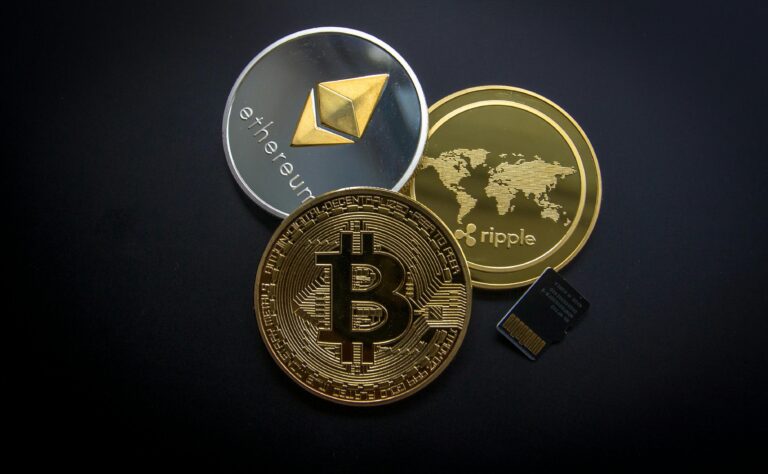Exploring the Types of Cryptocurrencies: Bitcoin, Ethereum, and Beyond
Uncover the diverse world of cryptocurrencies, including Bitcoin, Ethereum, and altcoins, in this detailed beginner’s guide.
Types of Cryptocurrencies: Bitcoin, Ethereum, and Altcoins
Cryptocurrencies have revolutionized the financial landscape, offering an alternative to traditional currencies and financial systems. This article explores the various types of cryptocurrencies, focusing on Bitcoin, Ethereum, and a range of altcoins. Understanding these different types will provide insight into their unique features, uses, and how they contribute to the broader cryptocurrency ecosystem.
What are Cryptocurrencies?
Cryptocurrencies are digital or virtual currencies that use cryptography for security. Unlike traditional currencies, they are decentralized and typically operate on technology called blockchain—a distributed ledger enforced by a network of computers (nodes). The decentralized nature of cryptocurrencies makes them resistant to government interference and manipulation.
Bitcoin: The Pioneer
Introduction to Bitcoin
Bitcoin (BTC), created by the mysterious Satoshi Nakamoto in 2009, is the first and most well-known cryptocurrency. It introduced the concept of decentralized digital currency and remains the largest cryptocurrency by market capitalization.
Origin
In October 2008, Nakamoto announced to the cryptography mailing list at metzdowd.com: “I’ve been working on a new electronic cash system that’s fully peer-to-peer, with no trusted third party.” The now-famous white paper published on Bitcoin.org, entitled “Bitcoin: A Peer-to-Peer Electronic Cash System,” would become the Magna Carta for how Bitcoin operates today.
First Block
On Jan. 3, 2009, the first Bitcoin block was mined. Called Block 0, it is also known as the genesis block and contains the text: “The Times 03/Jan/2009 Chancellor on brink of second bailout for banks,” perhaps proof that the block was mined on or after that date.
Key Features of Bitcoin
- Decentralization: Bitcoin operates on a peer-to-peer network, without a central authority.
- Limited Supply: Only 21 million bitcoins will ever exist, making it a deflationary asset.
- Security: Bitcoin uses proof-of-work (PoW) to secure the network, making it difficult to alter transaction history.
- Transparency: All transactions are recorded on a public ledger called the blockchain.
Takeaways
- Launched in 2009, bitcoin is the world’s largest cryptocurrency by market capitalization.
- Unlike fiat currency, bitcoin is created, distributed, traded, and stored using a decentralized ledger system known as a blockchain.
- Bitcoin and its ledger are secured by the number of participants in its network and in the way the system confirms and verifies transactions.
- Bitcoin can be purchased on various cryptocurrency exchanges.
Bitcoin’s history as a store of value has been turbulent; it has undergone several boom and bust cycles over its relatively short lifespan.
Use Cases of Bitcoin
- Digital Gold: Bitcoin is often referred to as digital gold due to its limited supply and store of value properties.
- Medium of Exchange: Bitcoin can be used for purchasing goods and services from merchants who accept it.
- Remittances: Bitcoin provides a low-cost method for cross-border money transfers.
Risks of Investing in Bitcoin
Bitcoin had a price of $7,167.52 on Dec. 31, 2019, and a year later, it had appreciated more than 300% to $28,984.98. It continued to surge in the first half of 2021, trading at a record high of $69,000 in November 2021. It then fell over the next few months to hover around $40,000.
As a result of such price movements, many people purchase bitcoin for its investment value rather than its ability to act as a medium of exchange. However, the lack of guaranteed value and its digital nature mean its purchase and use carry several inherent risks.
Here are some of the risks that you’re exposed to when trading or investing in bitcoin:
- Regulatory risk: The continuous battle between cryptocurrency-related projects and regulators makes longevity and liquidity an unknown. As of May 2024, bitcoin is not considered a security by the authorities, but that stance could change in the future.
- Security risk: Most individuals who own and use bitcoin have not acquired their tokens through mining operations. Rather, they buy and sell bitcoin and other digital currencies on popular cryptocurrency exchanges. These exchanges are entirely digital and are at risk from hackers, malware, and operational glitches.
- Insurance risk: Bitcoin and other cryptocurrencies are not insured by the Securities Investor Protection Corporation (SIPC) or the Federal Deposit Insurance Corporation (FDIC). However, some exchanges provide insurance through third parties. For instance, Gemini and Coinbase offer cryptocurrency insurance, but only for failures in their systems or cybersecurity breaches. Any cash deposits you’ve made at either exchange might be eligible for “pass-through” FDIC coverage.
- Fraud risk: Even with the security measures inherent within a blockchain, there are still opportunities for fraudulent activity.
- Market risk: As with any investment, bitcoin values can fluctuate. Indeed, the currency’s value has seen wild price swings over its short existence. Subject to high volume buying and selling on exchanges, it is highly sensitive to any newsworthy events.
How Many Bitcoins Are Left?
The total number of bitcoins in existence was about 19.7 million on May 15, 2024. At that time, the number left to be mined was about 1.3 million.
The Bottom Line
Bitcoin was the first cryptocurrency introduced to the public and was intended to be used as a form of payment outside of legal tender. Since its introduction in 2009, bitcoin’s popularity has surged, and its blockchain uses have expanded.
Though the process of generating bitcoin is complex, investing in it is more straightforward. Investors and speculators can buy and sell bitcoin on crypto exchanges. As with any investment, particularly one as new and volatile as bitcoin, investors should carefully consider if bitcoin is the right investment for them.
Ethereum: The Smart Contract Platform
Introduction to Ethereum
The Ethereum price is $3,686.43, a change of -3.39% over the past 24 hours as of 12:43 p.m. The recent price action in Ethereum left the tokens market capitalization at $442.92B. So far this year, Ethereum has a change of 61.45%. Ethereum is classified as a Smart Contract Platform under CoinDesks Digital Asset Classification Standard (DACS).
Ethereum is a blockchain-based software platform that can be used for sending and receiving value globally with its native cryptocurrency, ether, without any third-party interference. But it can also do much more than that.
First proposed in 2013 by Russian
Canadian computer programmer Vitalik Buterin, Ethereum was designed to expand the utility of cryptocurrencies by allowing developers to create their own special applications. Unlike traditional apps, these Ethereum-based applications, called “decentralized applications,” or dapps, are self-executing thanks to the use of smart contracts.
Smart contracts are code-based programs that are stored on the Ethereum blockchain and automatically carry out certain functions when predetermined conditions are met.
That can be anything from sending a transaction when a certain event takes place or loaning funds once collateral is deposited into a designated wallet. The smart contracts form the basis of all dapps built on Ethereum, as well as all other dapps created across other blockchain platforms.
Ether price
In August 2014, Ethereum launched its native token, ether, through an initial coin offering (ICO). Some 50 million ETHs were sold at a price of $0.31 per coin, raising over $16 million for the project.
Unlike many other cryptocurrencies, Ethereum’s cryptocurrency has an unbounded supply, meaning there is no limit to how many ether can enter circulation.
The reductions in block rewards aren’t programmed into Ethereum’s code like Bitcoin’s halving events are. Instead, members of the community propose changes, called “Ethereum Improvement Proposals,” or EIPs, and the rest of the community votes on whether to include the proposals in updates to Ethereum’s software code. Here is a breakdown of ether’s issuance schedule to date.
- Block 0 to Block 4,369,999: 5 ether
- Block 4,370,000 to 7,280,000: 3 ether (changed via EIP-649)
- Block 7,280,000 to now: 2 Ether (changed via EIP-1234)
By January 2018, ETH’s price peaked at $1,418 before it fell sharply.
It took about three years for the second-largest cryptocurrency by market cap (behind bitcoin) to retest its previous all-time high price. Between February and May 2021, eth’s price more than tripled to set a new all-time high of $4,379.
How staking works on Ethereum
Staking on the Ethereum blockchain is a process that is part of its consensus mechanism, specifically the Proof-of-Stake (PoS) model, which Ethereum transitioned to with the Ethereum Merge.
In contrast to the Proof-of-Work (PoW) model, where miners solve complex mathematical problems to validate transactions and create new blocks, the PoS model instead chooses validators based on the number of tokens they are willing to “stake” or lock up as collateral.
- To become a validator, a network participant must stake a certain amount of Ether (ETH), Ethereum’s native cryptocurrency. Currently, this amount is set at 32 ETH.
- Once a participant has staked their ETH, they can become a validator. Validators are responsible for proposing new blocks to be added to the blockchain and validating transactions.
- The protocol randomly selects a validator to propose a new block, and the selected validator’s proposed block is then checked by other validators. If the majority of validators agree on the validity of the new block, it is added to the blockchain.
- Validators are incentivized to act honestly and maintain the network’s integrity because they risk losing a portion, or even all, of their staked ETH if they try to validate fraudulent transactions or otherwise act maliciously (a process known as slashing).
- In return for staking their ETH and participating in the validation process, validators are rewarded with additional ETH. These rewards come in the form of new ETH generated by the network’s inflation, as well as transaction fees from the blocks they validate.
Ethereum token standards
Ethereum token standards are the blueprints for creating tokens that are compatible with the broader Ethereum network. These include tokens that can be traded for one another (fungible) as well as tokens that are inherently unique and cannot be mutually exchanged (NFTs). Ethereum token standards were invented by Ethereum developers to help users create new digital currencies more easily, faster and cheaper than starting from scratch.
While there are several different token standards known as “ERC” deployed on the ethereum network, three are commonly used:
- ERC-20: For creating fungible tokens that have similar properties to bitcoin and other mainstream cryptocurrencies.
- ERC-721: For creating non-fungible, unique tokens such as NFTs.
- ERC-1155: A multi-token standard used for creating fungible, non-fungible and semi-fungible tokens.
Key Features of Ethereum
- Smart Contracts: Automated agreements that execute when predefined conditions are met.
- Ethereum Virtual Machine (EVM): Allows developers to create dApps and execute smart contracts.
- ERC-20 Tokens: Standard for creating tokens on the Ethereum blockchain, facilitating the development of various projects and Initial Coin Offerings (ICOs).
- Transition to Proof of Stake (PoS): Ethereum is transitioning from PoW to PoS to improve scalability and reduce energy consumption.
Use Cases of Ethereum
- Decentralized Finance (DeFi): Ethereum is the backbone of the DeFi ecosystem, enabling lending, borrowing, and trading without intermediaries
- Non-Fungible Tokens (NFTs): Unique digital assets representing ownership of digital or physical items.
- dApps: Applications that run on the Ethereum blockchain, ranging from games to financial services.
Altcoins: Beyond Bitcoin and Ethereum
What Is an Altcoin?
Altcoins are generally defined as all cryptocurrencies other than Bitcoin (BTC). However, some people consider altcoins to be all cryptocurrencies other than Bitcoin and Ethereum (ETH) because most cryptocurrencies are forked from one of the two. Some altcoins use different consensus mechanisms to validate transactions, open new blocks, or attempt to distinguish themselves from Bitcoin and Ethereum by providing new or additional capabilities or purposes.
Altcoins refer to all cryptocurrencies other than Bitcoin. They include a vast array of projects, each with unique features and use cases. Some notable altcoins include:
Litecoin (LTC)
- Introduction: Created by Charlie Lee in 2011, Litecoin is often referred to as the silver to Bitcoin’s gold.
- Key Features: Faster transaction times and a different hashing algorithm (Scrypt).
- Use Cases: Peer-to-peer transactions and as a testbed for Bitcoin features.
Ripple (XRP)
- Introduction: Ripple aims to facilitate real-time, cross-border payment systems.
- Key Features: Consensus algorithm and partnerships with financial institutions.
- Use Cases: International remittances and interbank transactions.
Cardano (ADA)
- Introduction: Founded by Charles Hoskinson, Cardano focuses on creating a sustainable and scalable blockchain.
- Key Features: Proof of Stake (PoS) consensus and a layered architecture.
- Use Cases: Smart contracts, dApps, and educational purposes.
Polkadot (DOT)
- Introduction: Polkadot aims to enable different blockchains to interoperate.
- Key Features: Multi-chain framework and cross-chain compatibility.
- Use Cases: Interoperability between blockchains and decentralized applications.
Binance Coin (BNB)
- Introduction: Launched by Binance, one of the world’s largest cryptocurrency exchanges.
- Key Features: Used for transaction fees on the Binance platform and participating in token sales.
- Use Cases: Trading fee discounts, payment for services, and DeFi applications.
Latest Updates in the Cryptocurrency World
As of 2024, the cryptocurrency landscape continues to evolve rapidly. Some of the latest updates include:
- Ethereum 2.0: Ethereum’s transition to a Proof of Stake (PoS) consensus mechanism is nearing completion, promising improved scalability and reduced energy consumption.
- Regulatory Developments: Governments worldwide are increasingly focusing on regulating the cryptocurrency sector. The European Union, for instance, is working on the Markets in Crypto-Assets (MiCA) regulation to provide a clear legal framework.
- Bitcoin Halving: The next Bitcoin halving, expected in 2024, will reduce the block reward from 6.25 BTC to 3.125 BTC, potentially impacting its price and mining dynamics.
- Adoption by Institutions: Major financial institutions continue to integrate cryptocurrencies into their services, providing more legitimacy and widespread use. Companies like PayPal, Visa, and Mastercard have expanded their crypto offerings.
- Stablecoins: Stablecoins like USDT, USDC, and DAI are gaining popularity for their ability to maintain stable value, making them suitable for everyday transactions and a safe haven during market volatility.
The Future of Cryptocurrencies
The future of cryptocurrencies looks promising, with several trends shaping the industry:
- Increased Adoption: More businesses and consumers are likely to adopt cryptocurrencies for everyday transactions and investments.
- Regulatory Clarity: As governments establish clear regulations, the industry will gain more legitimacy and security.
- Technological Advancements: Innovations like quantum computing and further developments in blockchain technology will drive the evolution of cryptocurrencies.
- Integration with Traditional Finance: Cryptocurrencies will increasingly integrate with traditional financial systems, providing seamless bridges between fiat and digital currencies.
Conclusion
Understanding the types of cryptocurrencies—Bitcoin, Ethereum, and various altcoins—provides a comprehensive view of the diverse and dynamic cryptocurrency market. Bitcoin serves as the foundational digital currency, Ethereum expands possibilities with smart contracts, and altcoins offer specialized solutions across different sectors. As the cryptocurrency space continues to grow and evolve, staying informed about these key players and their developments is crucial for anyone interested in the future of finance.
FAQs
What are stablecoins and how do they differ from other cryptocurrencies? Stablecoins are a type of cryptocurrency designed to maintain a stable value by being pegged to a reserve of assets, often fiat currencies like the US Dollar. This stability makes them suitable for everyday transactions and as a store of value, unlike more volatile cryptocurrencies like Bitcoin and Ethereum.
How can I buy cryptocurrencies like Bitcoin and Ethereum? You can buy cryptocurrencies on various exchanges such as Coinbase, Binance, and Kraken. These platforms allow you to purchase cryptocurrencies using fiat money (like USD, EUR) or other cryptocurrencies. Ensure you use a secure and reputable exchange and consider using a hardware wallet for added security.
What is a crypto wallet and why do I need one? A crypto wallet is a digital tool that allows you to store, send, and receive cryptocurrencies. There are different types of wallets, including hardware wallets, software wallets, and paper wallets. Wallets provide a secure way to manage your cryptocurrency holdings and protect them from theft and hacking.



